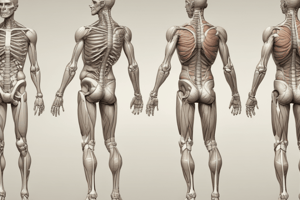Podcast
Questions and Answers
What type of joint is characterized by having no joint cavity?
What type of joint is characterized by having no joint cavity?
- Diarthrosis
- Synovial
- Fibrous (correct)
- Cartilaginous
Which functional classification of joints allows for moderate movement?
Which functional classification of joints allows for moderate movement?
- Diarthrosis
- Synarthrosis
- Fibrous
- Amphiarthrosis (correct)
Which of the following joints contains a joint cavity?
Which of the following joints contains a joint cavity?
- Fibrous joints
- Cartilaginous joints
- Synovial joints (correct)
- Amphiarthrotic joints
What is the primary characteristic of synovial joints?
What is the primary characteristic of synovial joints?
Which type of joint is functionally classified as synarthrosis?
Which type of joint is functionally classified as synarthrosis?
What is the correct classification of cartilaginous joints?
What is the correct classification of cartilaginous joints?
What is a key structural difference between fibrous and synovial joints?
What is a key structural difference between fibrous and synovial joints?
Which joint type is associated with a high degree of freedom?
Which joint type is associated with a high degree of freedom?
Flashcards
Joint
Joint
An articulation where two or more bones are joined by soft tissue.
Fibrous Joint
Fibrous Joint
A joint with no joint cavity, allowing little to no movement.
Cartilaginous Joint
Cartilaginous Joint
A joint with no joint cavity, allowing moderate movement.
Synovial Joint
Synovial Joint
Signup and view all the flashcards
Synarthrosis
Synarthrosis
Signup and view all the flashcards
Amphiarthrosis
Amphiarthrosis
Signup and view all the flashcards
Diarthrosis
Diarthrosis
Signup and view all the flashcards
Classification of Synovial Joints
Classification of Synovial Joints
Signup and view all the flashcards
Study Notes
Articular System - Classification of Joints
- Joints: Articulations where two or more bones connect via soft tissue.
- Joint Functions:
- Enable movement, facilitated by muscles.
- Provide shock absorption, with cartilage, menisci, and synovial fluid.
- Establish stability, via ligaments and a joint capsule.
- Maintaining a balance between mobility and stability is crucial; one characteristic can be compromised to gain the other. Structures like menisci or articular discs can enhance stability.
Structural Classification of Joints
- Fibrous Joints: No joint cavity; bones connected by dense fibrous connective tissue. They permit little to no movement and provide shape and support. (Examples: sutures in the skull, gomphosis, syndesmosis).
- Cartilaginous Joints: No joint cavity; bones connected by cartilage (hyaline or fibrocartilage). Permit limited movement and support. (Examples: Symphysis—pubic symphysis, intervertebral discs; Synchondrosis—sternocostal joint, epiphyseal plates).
- Synovial Joints: Contain a joint cavity; bones are separated by a fluid-filled space. They are highly mobile.
Functional Classification of Joints
- Synarthroses: Permit little to no movement, typical of fibrous joints.
- Amphiarthroses: Allowing moderate movement, characteristic of cartilaginous joints.
- Diarthroses: High mobility. Typical of synovial joints.
Synovial Joint Components
- Joint Capsule: An outer fibrous and inner synovial membrane that encapsulates the joint.
- Synovial Membrane: Produces synovial fluid; this is impacted by stress and friction on the joint surfaces.
- Synovial Fluid: A viscous fluid that reduces friction within the joint.
- Hyaline Cartilage: Covers the articulating surfaces of bones within the joint; it is also supported nutritionally by the synovial fluid.
- Ligaments: Fibrous structures that connect bones, either within or outside the joint capsule.
- Menisci/Articular Discs: Structures that form congruency to increase stability (often found in diarthrotic joints).
Classification of Synovial Joints Based on Degrees of Freedom
- Uniaxial Joints: Allow movement around one axis in one plane.
- Hinge Joints: Elbow, knee, and ankle joints—one surface is spool-like, other is concave shape.
- Pivot Joints: Atlantoaxial joint and superior/inferior radioulnar joints—one surface is ring shaped; the other surface rotates in the ring.
- Biaxial Joints: Allow motion around two axes in two planes.
- Condyloid (Ellipsoid) Joints: Radiocarpal joints, metacarpophalangeal joints of fingers 2–5. (one bone concave, the other convex).
- Saddle Joints: Carpometacarpal joint of the thumb, sternoclavicular joint—(each bone has a convex and a concave part).
- Triaxial Joints: Allow movement around three axes in three planes.
- Ball and Socket Joints: Glenohumeral (shoulder) and hip joints—(one bone has a convex ball-like surface that fits into the concave socket of the other bone).
- Nonaxial Joints: Permit gliding/sliding movements; intercarpal joints, facet joints.
Studying That Suits You
Use AI to generate personalized quizzes and flashcards to suit your learning preferences.




